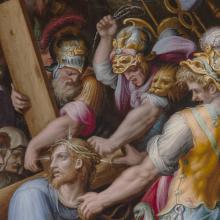Giorgio Vasari & Court Culture in Late Renaissance Italy
Often billed as the first art historian, Giorgio Vasari (1511–1574) is best known as the author of Lives of the Most Excellent Painters, Sculptors, and Architects, a compilation of artists’ biographies that was among the first of its kind. The majority of scholarship on Vasari’s life and work is devoted to Lives, but he was also a successful painter and architect. This exhibition celebrates the Spencer Museum’s small but important Vasari panel depicting Christ Carrying the Cross. The painting belonged to Vasari’s close friend and collaborator Vincenzo Borghini (1515–1580). Indeed, the exhibition reunites Vasari’s Christ Carrying the Cross with its pendant from Borghini’s collection, a painting attributed to Ventura di Vincenzio Ulivieri (called Livo) that depicts St. Paul’s conversion from Judaism to Christianity.
Giorgio Vasari & Court Culture in Late Renaissance Italy investigates the place Vasari’s Christ Carrying the Cross occupies within Vasari’s career and 16th-century Florentine and Roman court culture. Additionally, it documents the painting’s technique, condition, and recent restoration. The exhibition also brings together many of the graphic images that inspired the panel and explores Vasari’s relationship with Michelangelo. Capitalizing on the Spencer Museum’s rich collection of late medieval and early modern religious art and the Spencer Research Library’s extensive holdings of rare, early modern Italian books, this exhibition situates Christ Carrying the Cross within its visual, historical, and literary contexts. In doing so, it demonstrates the significance of a local treasure for the first time since it entered the University of Kansas’ art collection in 1953.
Giorgio Vasari & Court Culture in Late Renaissance Italy is made possible by the generous support of the Samuel H. Kress Foundation and the Art Mentor Foundation Lucerne. It was curated by Sally J. Cornelison, Associate Professor of Italian Renaissance Art in KU’s Kress Foundation Department of Art History, with the assistance of Susan Earle, Spencer Museum of Art Curator of European & American Art.



















